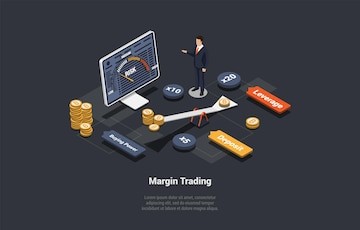In the world of forex trading, one of the most important concepts to grasp is leverage. Leverage allows traders to control larger positions in the market by borrowing money from their broker. It is a powerful tool that can amplify both profits and losses. In this comprehensive guide, we will explore what leverage is, how it works, its benefits, and the risks associated with it. So, let’s dive in and gain a thorough understanding of forex leverage.
1.What is Leverage in Forex Trading?
Leverage in forex trading refers to the use of borrowed funds to control a larger trading position than what would be possible with the trader’s own capital alone. It allows traders to amplify their potential profits by increasing their exposure to the market. Leverage is provided by the broker and enables traders to enter larger trades with a smaller initial investment.
2. How Does Leverage Work?
To understand how forex leverage works, let’s consider an example. Suppose you have $1,000 in your trading account and your broker offers a leverage ratio of 100:1. This means that for every dollar you have in your account, you can control $100 in the market. With this leverage, you can open a position of $100,000 in a currency pair.
When you trade with leverage, your broker will require you to have a certain amount of margin in your account as collateral. Margin is a percentage of the total trade size that needs to be maintained in the account. In the example above, if the margin requirement is 1%, you would need to have $1,000 in margin to open a $100,000 position.
Leverage allows you to magnify your potential profits. For instance, if the price of the currency pair you are trading moves in your favour by 1%, your profit would be $1,000. However, it’s important to note that leverage can also magnify your losses if the price moves against you.
3. Benefits of Using Leverage
Using leverage in forex trading offers several benefits to traders:
3.1 Increased Market Exposure
Leverage allows traders to enter larger positions in the market than they would be able to with their own capital. This increased market exposure provides opportunities to profit from small price movements in currency pairs.
3.2 Enhanced Profit Potential
By controlling larger positions, traders have the potential to earn higher profits. Even small price movements can result in significant gains when trading with leverage.
3.3 Access to More Markets
Leverage opens up access to a wide range of markets, including major currency pairs, minor pairs, and exotic pairs. It allows traders to diversify their portfolios and take advantage of different market conditions.
3.4 Lower Capital Requirements
With leverage, traders can participate in the forex market with a smaller initial investment. This makes forex trading more accessible to retail traders who may not have a large amount of capital to invest.
4. Risks of Using Leverage
While leverage can enhance profit potential, it also comes with significant risks. It’s important for traders to understand and manage these risks effectively. Here are some key risks associated with using leverage in forex trading:
4.1 Increased Losses
Just as leverage can amplify profits, it can also magnify losses. If the market moves against your position, losses can exceed the amount of capital you have in your account. It’s crucial to have a risk management strategy in place to limit potential losses.
4.2 Margin Calls
If your account balance falls below the required margin level, your broker may issue a margin call. This means that you need to deposit additional funds into your account to maintain your open positions. Failure to meet a margin call may result in the automatic closure of your trades.
4.3 Volatility
The forex market is known for its volatility, with prices fluctuating rapidly. While volatility can present trading opportunities, it can also increase the risk of sharp price movements that can lead to significant losses when trading with leverage.
4.4 Emotional Stress
Trading with leverage can be emotionally challenging, especially during periods of high market volatility. The potential for large gains or losses can induce fear and greed, leading to impulsive trading decisions. It’s important to remain disciplined and adhere to a trading plan.
5. Calculating Leverage
Leverage is calculated by dividing the total value of the trade by the margin required. The leverage ratio indicates how much of your own capital is being used to control a larger position in the market. Let’s look at an example to understand how leverage is calculated:
Suppose you want to open a position of $100,000 in a currency pair and your broker requires a margin of 1%. To calculate the leverage, divide the total value of the trade by the margin requirement:
Leverage = Total Value of Trade / Margin Required
In this case, the leverage would be 100:1 ($100,000 / $1,000). This means that for every dollar of your own capital, you control $100 in the market.
6. Leverage Ratios
Leverage ratios determine the amount of leverage available to traders. Different brokers may offer varying leverage ratios based on their margin requirements. The leverage ratio represents the multiple by which your position is magnified. Let’s explore some common leverage ratios:
6.1 10:1 Leverage Ratio
A leverage ratio of 10:1 means that for every dollar in your account, you can control $10 in the market. This ratio is generally considered low and provides a conservative level of leverage.
6.2 50:1 Leverage Ratio
With a leverage ratio of 50:1, you can control $50 in the market for every dollar of your own capital. This ratio is commonly offered by brokers and provides a moderate level of leverage.
6.3 100:1 Leverage Ratio
A leverage ratio of 100:1 allows you to control $100 in the market for every dollar in your account. This ratio is widely available and provides a higher level of leverage.
6.4 500:1 Leverage Ratio
Some brokers offer leverage ratios as high as 500:1. With this ratio, you can control $500 in the market for every dollar of your own capital. However, it’s important to note that higher leverage ratios also come with increased risk.
7. Margin Requirements
Margin requirements determine the percentage of the total trade size that needs to be held as collateral in your trading account. The margin requirement is set by the broker and can vary based on the currency pair being traded and market conditions. Let’s explore some key considerations regarding margin requirements:
7.1 Initial Margin
When opening a trade, you need to have a certain amount of margin in your account as collateral. This is known as the initial margin requirement. The initial margin is usually a percentage of the total trade size.
7.2 Maintenance Margin
In addition to the initial margin, brokers may also require a maintenance margin. The maintenance margin is the minimum amount of margin that needs to be maintained in your account to keep your positions open.
7.3 Margin Calls
If your account balance falls below the required margin level, your broker may issue a margin call. This means you need to deposit additional funds into your account to meet the margin requirements. Failure to do so may result in the closure of your positions.
8. Managing Leverage
Managing leverage is crucial for long-term success in forex trading. Here are some important tips for effectively managing leverage:
8.1 Understand Your Risk Tolerance
Before using leverage, it’s essential to assess your risk tolerance. Determine how much capital you are willing to risk on each trade and set a maximum leverage ratio accordingly.
8.2 Use Stop Loss Orders
Implementing stop loss orders is a key risk management strategy. A stop loss order automatically closes your position if the price reaches a specified level, limiting potential losses. Be sure to set stop loss levels based on your risk tolerance and market analysis.
8.3 Diversify Your Trades
Avoid putting all your capital into a single trade. Diversify your trades across different currency pairs to spread the risk. This helps protect your account from significant losses if one trade goes against you.
8.4 Regularly Monitor Your Positions
Keep a close eye on your open positions and the market conditions. Stay updated with relevant news and economic events that can impact the forex market. Regular monitoring allows you to make informed decisions and take necessary actions to protect your capital.
9. Risk Management Strategies
Implementing effective risk management strategies is crucial when trading with leverage. Here are some strategies to consider:
9.1 Set Risk Limits
Establish clear risk limits for each trade. Determine the maximum percentage of your trading capital that you are willing to risk on any single trade. This helps protect your account from excessive losses.
9.2 Use Proper Position Sizing
Proper position sizing is essential for managing risk. Calculate the appropriate position size based on your risk tolerance, stop loss level, and leverage. Avoid overexposing your account by trading larger positions than you can afford.
9.3 Maintain Adequate Capital
Ensure that you have sufficient capital in your account to absorb potential losses. Avoid overleveraging and risking a significant portion of your trading capital on a single trade.
9.4 Regularly Review and Adjust
Regularly review your risk management strategies and make necessary adjustments based on your trading performance and market conditions. Learning from past trades and continuously improving your risk management approach is key to long-term success.
10. Choosing the Right Leverage
Choosing the right leverage for your trading style and risk tolerance is crucial. Consider the following factors when selecting the appropriate leverage:
10.1 Experience and Skill Level
Beginner traders with limited experience may want to start with lower leverage ratios to reduce the risk of significant losses. As you gain experience and develop your trading skills, you can gradually increase the leverage ratio.
10.2 Risk Appetite
Assess your risk appetite and determine how much risk you are comfortable with. Conservative traders may prefer lower leverage ratios, while more aggressive traders may opt for higher leverage to maximise profit potential.
10.3 Market Conditions
Consider the current market conditions when determining the appropriate leverage. Volatile markets may require lower leverage to manage risk effectively, while stable markets may allow for higher leverage ratios.
10.4 Trading Strategy
Your trading strategy should also influence your choice of leverage. Some strategies may require higher leverage to capitalise on short-term price movements, while others may be better suited to lower leverage ratios for long-term positions.
11. Conclusion
In conclusion, leverage is a powerful tool that can greatly enhance profit potential in forex trading. However, it also comes with significant risks that need to be managed effectively. By understanding how leverage works, calculating leverage ratios, and implementing proper risk management strategies, traders can navigate the forex market with confidence. Remember to choose the right leverage ratio based on your risk tolerance, experience, and market conditions. With proper knowledge and discipline, leverage can be a valuable asset in your forex trading journey.



































